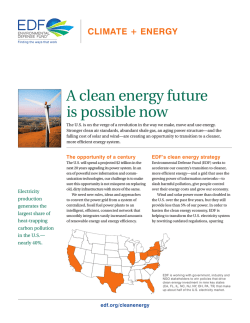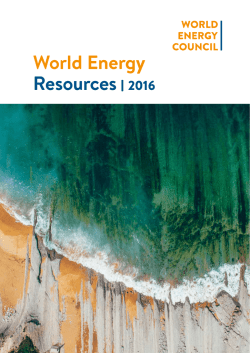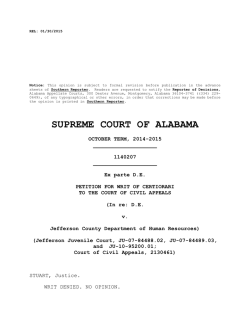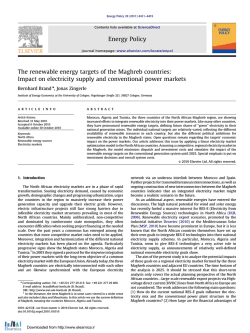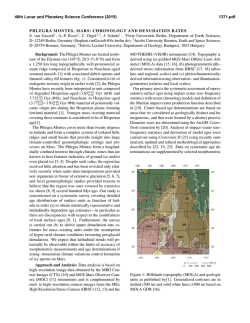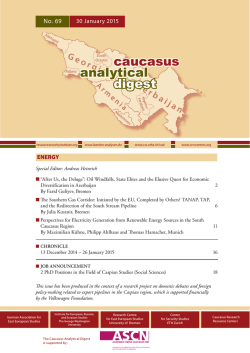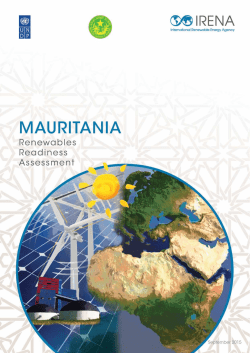
electricity industry trends and figures
a sector in transformation:
electricity industry trends and figures
A EURELECTRIC report
January 2015
EURELECTRIC represents the common interests of the electricity industry at
pan-European level. Our current members represent the electricity industry in over
30 European countries. We also have affiliates and associates on several other
continents.
Our well-defined structure of expertise ensures that input to our policy positions,
statements and in-depth reports comes from several hundred active experts
working for power generators, supply companies or distribution system operators
(DSOs).
We have a permanent secretariat based in Brussels, which is responsible for the
overall organisation and coordination of EURELECTRIC’s activities.
EURELECTRIC pursues in all its activities the application
of the following sustainable development values:
Economic Development
Environmental Leadership
commitment, innovation, pro-activeness
Social Responsibility
transparency, ethics, accountability
January 2015
Contents
1
2
3
4
5
6
Key Messages
04
Energy Policy Context
06
Demand
10
Electricity Generation
12
Capacity and Investment
14
Markets
16
Environment
18
A sector in transformation: Electricity industry trends and figures
01
02
A sector in transformation: Electricity industry trends and figures
Intro
The present report aims to introduce the readers to the new dynamics of the
‘energy transition’ and how it impacts both energy policy/regulation and
businesses. The report outlines the efforts carried out by the power industry
in adapting to these changes with the objective of delivering continuous
safe, affordable and cost efficient electricity supply to its customers.
The report is based on the latest available industry figures (2013) gathered
from the EURELECTRIC statistical experts and complemented by publicly
available information. The data contained in this report covers 34 countries,
namely the 28 EU Member States as well as Norway, Switzerland, Iceland,
Turkey, Serbia and Ukraine, and addresses respectively demand,
generation, capacity and investment.
In outlining the new trends and data, the report examines the policy
context, the evolution of fundamentals such as production and demand,
and provides a brief outlook of market developments, prices and
environmental performances.
We would like to express our sincere gratitude to all contributing experts in
particular country data experts.
A sector in transformation: Electricity industry trends and figures
03
key messages
Energy Policy
Context
04
Demand
Electricity
generation
empowering
companies to
cost-efficiently meet
the decarbonisation
agenda
stagnating with
differences across
countries/customers
Going green
The energy transition
requires prompt and
necessary policy and
market adaptations to
allow power companies to
bridge the investment gap
and offer a continued safe
and affordable electricity
supply to its customers. It
is thus vital to reinforce
the EU Emission Trading
System and achieve a
well-connected
and
integrated power market
where both flexibility and
capacity are properly
valued.
Demand in the Nordic
area and Germany was
roughly the same in 2013
as ten years ago while it
continued to increase in
Eastern
Europe.
Consumption
by
households and services
has steadily increased
since 2004 in contrast to
industry consumption.
In 2013, for the second
consecutive year, more
than half of the electricity
generated in Europe came
from low-carbon sources.
Renewables generation
continued to increase,
nuclear
production
remained stable and
fossil fuel fired generation
fell sharply.
1
2
3
A sector in transformation: Electricity industry trends and figures
Capacity and
investment
Markets
Environment
the investment
gloom
customers not
reaping the full
benefits
as capacity gets
greener, CO2
goes down
Renewable energy plants
continued to be added to
the system but at a more
moderate
pace,
suggesting a decline in
the volume of subsidies.
Power companies are
facing a major investment
dilemma as current levels
of wholesale electricity
prices are too low to
incentivise investment in
most
existing
technologies
and
in
particular back-up plants
that are needed for the
security of the system.
Whilst markets continue
to integrate and become
more
liquid,
the
expected benefits have
been more moderate,
with limited or even
declining
price
convergence. Declining
wholesale
prices
combined with a sharp
rise in policy costs/levies
and an increasingly
complex energy policy
environment
are
preventing
customers
from feeling the full
benefits
of
market
integration.
With
increased
generation
from
Renewables
sources,
new RES capacity being
commissioned
and
further improvements in
energy efficiency, 2013
saw a marked decline in
CO2 emissions. However,
the ongoing surplus of
more than 2 billion
allowances continues to
depress the CO2 price.
Reinforcing
the
ETS
through a more flexible
design, so that it delivers
a robust carbon price that
supports
continued
investment in low carbon
technologies, remains an
urgent and vital policy
objective.
4
5
6
A sector in transformation: Electricity industry trends and figures
05
Energy Policy Context
1
Redirecting energy policies towards
greater competitiveness and affordability
The adoption of the EU’s 20-20-20 energy and climate policy
framework back in 2009 was the first step in Europe’s global
policy approach aimed at decarbonising its economy and
combating global warming. This set a strong signal in favour of
investment in renewable energy sources (RES): As the 20-20-20
package was being implemented, investment in variable RES
peaked at levels of over € 130 billion per annum. Altogether
€ 470 billion went into these technologies from 2010 to 2013,
showing the tremendous efforts made in meeting the RES target
and initiating profound transformative changes in the power
sector.
In 2013, for the second year in a row, more than half of the
electricity generated in Europe came from low-carbon facilities.
Of the 3101 TWh of electricity produced in 2013 in EU 28, 27%
came from renewables and another 27% from nuclear. The
structure of the power industry is changing rapidly, with a
growing diversification of its portfolio towards variable
generation sources and a stronger focus on developing smart
meters and empowering customers. Of the newly installed
renewables capacity in 2013, 80% were added by large utilities,
making the European utility business a world sustainability
leader 1 . These results are a direct consequence of the
commitments made by power companies since the inception of
the EU’s climate policies to actively contribute to the
decarbonisation process.
Figure 1: Share of Low Carbon technologies versus other
in total electricity production in EU28
60%
55%
50%
Going down the decarbonisation path, the economic crisis that
hit Europe in 2009 and the prolonged effects of recession have
put strains on the European climate ambition, somewhat
blurring some of the results and placing increased emphasis on
policy costs. The evolution of power demand has been closely
correlated with the GDP curve in that Europe saw an overall
stagnation of electricity demand during the crisis with a decline
in 2009 and 2011. It is not entirely clear what proportion of this
stabilising demand was attributable to the underperforming
European economy and what was attributable to the
implementation of energy efficiency measures. In 2013
however, demand barely reached 2005 levels. The RES boom
that coincided with the economic crisis exacerbated the
disconnect between (lower) electricity demand and (increasing)
capacity, thereby making the conditions for the implementation
of the decarbonisation agenda more complex.
In 2013, the share of variable renewables generation
represented at least a quarter of the total electricity produced in
three EU countries (Denmark, Portugal and Spain) whilst in five
other EU countries (Ireland, Latvia, Greece, Germany and Italy),
it totalled 10 to 20% of their overall production. Whilst not being
the only contributor to a CO2-free electricity production, the
deployment of variable RES has played an instrumental role in
Europe’s efforts to decarbonise the broader economy.
However, the generation pattern of this new technology (being
variable, non-firm with high upfront investment costs and close
to zero marginal costs) is leading to considerable changes and a
major overhaul of the energy system. This is one of the lessons
of these early years of massive RES deployment: the policy shift
requires a holistic approach and well-suited adaptation
measures to ensure a continued secure and affordable supply.
Furthermore, keeping costs under control and as to make the
energy transition affordable for customers remains an important
objective 2.
45%
40%
Other
Low Carbon
2010
2011
2012
2013
Source: EURELECTRIC
1
2
06
The global utility ranking published in EI New Energy global in 2014 showed that, of the 100 Green Utilities selected on the basis of the volume of their renewable energy portfolio and
their greenhouse gas emissions, 6 out of the top 10 companies are European.
Between 2008 and 2012, customers saw their taxes and levies increase by as much as 31% for residential customers and 109% for industrial customers. In 2012, European households
spent an average of 39 €/MWh on taxes and 25 €/MWh on policy support costs.
A sector in transformation: Electricity industry trends and figures
Energy Policy Context
Figure 2: Share of variable RES * in the
2013 power mix
Figure 3: Share of non variable RES** in
the 2013 power mix
2013 Nuclear %
MT
CY
HU
IE
EE
NL
LU
GB
PL
BE
UA
CZ
BG
DE
GR
FR
ES
SK
DK
LT
EUREL
TK
IT
RS
RO
SI
FI
PT
SE
HR
AT
LV
CH
NO
IS
RS
IS
UA
CH
FI
NO
SI
LV
MT
SK
HU
HR
CZ
TK
FR
PL
EE
AT
LU
NL
SE
CY
BG
RO
BE
EUREL
GB
IT
DE
GR
LT
IE
ES
PT
DK
0% 5% 10% 15% 20% 25% 30% 35% 40%
* Variable RES includes wind and solar
0%
Figure 4: Share of nuclear in the 2013
power mix
20% 40% 60% 80% 100% 120%
RS
TK
PT
PL
NO
MT
LV
LU
LT
IT
IS
IE
GR
EE
DK
CY
AT
NL
DE
HR
GB
ES
RO
EUREL
FI
SI
BG
CZ
CH
SE
UA
BE
HU
SK
FR
0%
20% 40% 60% 80%
** Non variable RES includes hydro, biomass, biogas and
bioliquids, geothermal and other remaining renewable sources
Source: EURELECTRIC
Adapting the power sector to its transformative changes has
been on the agenda of the EU institutions and continues to be an
essential topic for the new European Commission and
Parliament. In 2014, some important steps were made with the
adoption of the State Aid Guidelines for Environmental
Protection and Energy on 9 April and the conclusions of the
European Energy Council in relation to the 2030 climate and
energy framework on 23-24 October.
Running from the 1 July 2014 up to the end of 2020, the state aid
guidelines issued by the European Commission aim to drive RES
schemes towards cost-efficiency and reduce market distortions.
In doing so, they introduce a gradual shift from rigid feed-in
tariffs to flexible premiums as a result of competitive processes.
They also make it obligatory for renewable generators to sell
their electricity in the market and take on grid balancing
responsibility. However, this does not apply to small
installations which can continue to benefit from generous
exemptions and not act in the market. This exemption is far from
marginal: in most countries more than half of the installed PV
capacity does not have to comply with these rules.
The second main policy achievement in 2014 aimed to make
decarbonisation policies more consistent with competitiveness.
On 23-24 October, the Heads of State and Government backed
the Commission proposal for an overarching energy and climate
framework for 2030 with, at its heart, a binding reduction of
domestic greenhouse gases of at least 40% below 1990 levels.
This target is accompanied by two important policy objectives,
namely the further deployment of RES through a European
binding target of at least 27% of EU energy consumption and
improvements in energy efficiency of at least 27%
(non-binding). Close consideration was given to the overarching
GHG reduction target in developing and calibrating these two
additional targets. In addition, the European Council meeting
paid due attention to expanding the grid, requesting the
Commission to monitor interconnection development with a
view to achieve a Commission’s target of 15% by 2030 . These
conclusions also include a new governance process whereby
governments will contribute through national plans for
competitive, secure and sustainable energy with a set of
indicators to assess progress and objectives over time.
A sector in transformation: Electricity industry trends and figures
07
Energy Policy Context
Figure 5: Agreed headline targets – 2030 Framework for
Climate and Energy
20 %
Renewable
Energy
- 20 %
2020
2030
Greenhouse
Gas Emissions
< 40 %
Greenhouse
Gas Emissions
> 27 %
Renewable
Energy
20 %
Energy
Efficiency
> 27 %
Energy
Efficiency
10 %
Interconnection
15 %
Interconnection
{
New governance system + indicators
Source: European Commission 2030 Framework for Climate & Energy, outcome of the
October 2014 European Council
Working towards a RES target that is solely binding on a
European level is a new way of achieving this policy goal that will
require further clarification in the course of 2015. In addition to
being the main focus of the energy and climate framework, the
40% GHG reduction target will be part of the EU negotiating
position at the United Nations Climate Change conference
(COP 21), which will take place in Paris in the first half of
December 2015. The announcement made on 12 November
2014 by the US and China – two economies that account for
more than a third of global greenhouse gas emissions – in favour
of controlling their carbon emissions is a promising signal
demonstrating that major international partners may be ready to
take on commitments in combatting climate change. However
greater efforts will be necessary to deliver an international
agreement at the COP 21 which may also in turn open the door
for possible review and adjustment in the current EU energy and
climate package endorsed in October 2014.
Even if some elements still have to be clarified further, the
conclusions of the European Council in October 2014
undoubtedly marked an important step in European
policy-making, showing a political will to redirect energy policies
towards greater competitiveness and affordability through more
consistent targets in the 2030 horizons.
08
A sector in transformation: Electricity industry trends and figures
As RES technologies become mature and are increasingly being
integrated into the market, the conclusions of the European
Council can be seen as the start of a new era where the ambition
of moving towards a low-carbon economy is pursued in an
increasingly holistic, technology-neutral and market-based
approach. Under this new framework, RES and conventional
generation need to build on their complementarity and
strengths. Achieving synergy between variable and back-up
generation together with setting incentives to reach such an
adequate balance is a cornerstone of the 2030 climate and
energy framework.
Over the last five years, the changes occurring in the power
markets have been profound and significant, showing the early
signs of the sector’s transformative efforts to achieve a
low-carbon economy. Whilst markets continue to integrate and
greater liquidity is being pursued with the coupling of spot
markets across Europe, the pattern of production has become
more versatile, leading to more volatile and declining wholesale
prices, increased congestion and reduced load factors of
back-up plants. The full potential arising from robust and
integrated wholesale markets remains however untapped as the
benefits of more integrated intra-day markets and balancing
arrangements have not yet been realised whilst they
are instrumental to enhance flexibility and accommodate
short-term system variations.
Another fundamental aspect of this quickly changing sector is
the displacement of generation units that are essential to
safeguard the system. Whilst variable RES generation
contributes to a low-carbon generation mix and to reducing
Europe’s energy dependency, this form of generation is heavily
dependent on weather conditions and can only be planned and
scheduled to a limited extent. It thus requires complementing it
with a form of firm generation that will act as a back-up. However
today many of the power markets face a paradox: they need
back-up plants to ensure a reliable electricity supply to
customers but they do not provide the right market incentives to
ensure that a sufficient level of back-up capacity is guaranteed.
Energy Policy Context
Moving forward, and building on this, a growing and major
concern lies in the investment gap that the European
decarbonisation agenda is faced with. From 2000 to 2012,
€ 1.1 trillion were spent in new power generation, of which three
quarters went to the renewables sector. This considerable
amount of new capacity played an instrumental role in engaging
Europe on a decarbonisation path.
However, the process is far from being completed as Europe
would need an additional 740 GW of generation capacity by
2035, making the EU the second largest economy after China to
upgrade and refurbish its generation fleet in such order of
magnitude 3. With the lowering of wholesale electricity prices
over the last years, - and taking into account the current running
hours of each technology-, the graph below shows that current
price levels do not allow investing in most of these technologies
(Figure 6). This illustrates the investment dilemma currently
faced by power companies and the difficulties of meeting the
decarbonisation ambition with today’s power prices in the
context of current energy policies and market framework.
However, the strengthening of the ETS mechanism and a
stronger carbon price could change this outcome significantly.
Europe will only be able to manage a successful decarbonisation
of the economy if the electricity industry becomes investable
again. And indeed, the challenge is immense: according to the
IEA, no less than €1.3 trillion of investment is needed by 2025
for generation, transmission and distribution. At a time where
variable RES are seeing a sharp decline in their technology costs,
are made more cost-effective and are being integrated into the
market, this raises the issue as to how to pursue investment in a
way that is market-based and technology-neutral.
Making renewable electricity affordable plays an important role
in the successful evolution of the European energy system. A
robust carbon price is the most cost-effective way to ensure the
optimum investment levels in low carbon technologies,
including RES are achieved. Other national and European
policies should be designed in a way that support the
effectiveness of the EU ETS.
Furthermore, it will be essential to properly value flexibility and
capacity so that plants are adequately remunerated to
accommodate both the short-term variations in the system and
the need for system back-up that delivers long-term adequacy.
Figure 6: Levelised Cost of Electricity (€/MWh) at realised full load hours in 2013
compared with Average Range of European Electricity Wholesale Price in 2013 4 5
400
350
Monthly Average Range European
Power Wholesale Price (PEP in €/MWh)
300
LCOE (€ /MWh)
250
200
150
100
50
l
Oi
Hy
Hy
dr
o
Ge Dam
dr
ot
o
- r herm
un
-o al
f-r
iv
er
Bi
om
L
as ign
sc
it
o- e
fir
in
g
Ha
W rd C
in
o
d
On al
Na sho
re
tu
ra
lG
Bi
as
om
N
P
as um ucl
pe ea
s(
wa d H r
st
yd
e/
r
pe o
W
l
le
Bi
in
ts
og d
as Of )
f
So & B sho
r
la
i
r P oliq e
V
ui
ds
So (M
o
la
r P unt
e
V
(ro d)
of
to
So p)
la
rC
SP
€-
Source:
•Alberici, S. et al. (2014). Subsidies and Costs of EU energy: An Interim Report. (DESNL14583). Utrecht, The Netherlands: Ecofys.
•Kost, C. et al. (2013). Levelized Cost of Electricity Renewable Energy Technologies - Study - Edition: November 2013. Freiburg, Germany: Fraunhofer Institute for Solar Energy Systems ISE.
•World Energy Council, & Bloomberg New Energy Finance. (2013). World Energy Perspective: Cost of Energy Technologies. London, UK: World Energy Council.
•Department of Energy & Climate Change. (2013). Electricity Generation Costs (December 2013). London, UK: Department of Energy & Climate Change.
•International Energy Agency. (2014). World Energy Outlook 2014. Paris, France: International Energy Agency.
3
4
5
IEA Investment Outlook, 2014
As these LCOE numbers are based on public studies (which take different realised full load hours (FLH) for all technologies in the different EU countries), we assume ‘average European’ FLH.
We acknowledge the drawbacks of LCOE comparisons. While they can provide a reflection of total costs, given high-quality assumptions, the broad set of technologies play such different
roles in the power system that they provide equally wide-ranging benefits or value to the energy system and investors.
A sector in transformation: Electricity industry trends and figures
09
Demand
2
Stagnating demand despite long-term increases
in power consumption from households and services
Total EU-28 electricity
e
it consumption has roughly
ity
r
roug
hly
l stayed on
ly
the same
ame level during the last two years,
r after ups and downs
rs,
experienced
ienced due to the economic
onomic crisis since 2008. Final
consumption
2012 to 2013, from
2,903
umption decreased by 1% from
r
rom
r
rom
T
to 2,867 TWh.
Power consumption is today on the same level
as in 2005, and lower than in the years right before the
economic crisis: in general power consumption by industry
has been decreasing while consumption by households and
services has increased steadily.
Most EU countries experienced a slight decrease in their power
consumption from 2012 to 2013. Electricity consumption in the
EU’s three biggest economies – Germany, France, and the United
Kingdom – remained almost constant, with year-on-year
changes in the range of +/-1%. Spain and Italy saw a moderate
decrease of power consumption by around 3%. Altogether final
consumption evened out across Europe, which witnessed a
converging development trend across countries – in contrast to
previous year-on-year changes between EU member states,
which had ranged from -9% to +9%. Notable exceptions are
Croatia, where final consumption increased by 8%, and Cyprus,
where it decreased by 10%. Changes in final consumption of
EFTA (Iceland, Norway, Switzerland) and Energy Community
(Serbia, Ukraine and observer Turkey) countries were similar to
those of EU countries, ranging between -3% (Iceland) and +3%
(Ukraine), and total final power consumption across all reporting
countries decreased from 3,485 to 3,450 TWh (1%).
Table 1: Final Consumption of electricity (TWh)
2012
65
65
Belgium
84
82
Bulgaria
29
29
Cyprus
4
4
Czech republic
59
59
Germany
534
528
Denmark
31
31
Estonia
Spain
7
239
82
82
France
453
457
United Kingdom
325
325
Greece
54
52
Hungary
36
36
Croatia
16
17
Ireland
26
24
Italy
307
297
Lithuania
10
10
Luxembourg
7
6
Latvia
7
7
Malta
2
2
Netherlands
109
107
Poland
137
134
Portugal
47
47
Romania
51
49
Sweden
132
130
Slovenia
13
13
Slovakia
29
29
Iceland
2.903
2.867
17
18
Switzerland
59
59
Norway
118
118
Turkey
195
199
Serbia
28
28
Ukraine
Total (all reporting countries)
A sector in transformation: Electricity industry trends and figures
7
246
Finland
Total (EU28)
10
2013
Austria
166
161
3.485
3.450
Demand
From a longer term perspective, however, major differences
between European regions emerge: consumption in the Nordic
area and Germany in 2012-2013 was largely at the same level as
ten years ago, while Eastern Europe has seen a significant
increase in electricity consumption and the consumption in the
United Kingdom has decreased by 6% since 2004. Over time,
GDP is closely correlated with power demand: during the
economic crisis, for instance, power demand mirrored GDP
trends. However whilst GDP in the EU-28 has picked up slightly,
power consumption no longer clearly follows such a trend,
suggesting possible less converging paths for GDP and power
consumption in the future. Possible explanations for these
diverging paths are the impact of energy efficiency measures,
the structural changes in European economies towards less
energy-intensive production processes and the growth of the
services sector.
Looking at different sectors, power consumption by industry is
lower today than it was ten years ago, while consumption by
households and services clearly increased between 2004 and
2012. In 2012, the three largest power consuming sectors in the
EU-28 were industry (36%), households (30%), and services
(30%). The rest was consumed by transport (2%) and by
agriculture, forestry and fishing (2%).
Figure 7: Share of Low Carbon technologies versus other in total electricity production in EU28
14000
GDP
Final consumption
Industry
Other sectors
3000
12000
2500
10000
2000
8000
1500
6000
1000
4000
0
GDP, Billion €
Electricity consumption, TWh
3500
0
2002
2004
2006
2008
2010
2012
2014
Source: EURELECTRIC
A sector in transformation: Electricity industry trends and figures
11
Electricity Generation
3
A slight overall decline that conceals
an increase in production from renewable sources
Aggregated
egated
ted net power generation decreased by just more
than 1% acro
across
r ss EU 28, from
ro
r
rom
3,136 TWh
T
in 2012 to 3,101 TWh
T
in
2013, fo
ffollowing
llowing the same
ame trend as power demand. Low-carbon
carbon
technologies
ologies accounted for
f
more than
h
half
h
l of total net
lf
generation
ration for
f
the second consecutive year, as RES
generation
ration continued to increase and fo
ffossil
ssil fuel fired
r
red
generation further steeply decreased. Nuclear production,
like overall generation, was stable.
Figure 8: Electricity Production by Primary Energy – EU28
2012
Pumped Hydro
1%
Other
1%
Renewables
24%
Fossil Fuel Fired
48%
Nuclear
27%
2013
Pumped Hydro
1%
Other
1%
Incre
crease in RES genera
enerat
ation co
c ntinues
In 2013 11% mor
more electricity generated by renewable primary
sources was fed into
in European electricity grids than in 2012.
The RES generation totalled 836TWh and the share of RES grew
by 3.05 percenta
percentage point in the EU-28 power mix. Power
generation by the key RES technologies grew by two-digit
figures, while generation by some less deployed technologies
decreased.
Wind: Wind powered generation grew by 15.5%, making up
29% of the total electricity generated from RES in 2013. Of this
wind share off-shore generation increased by 27% and
contributed 22 TWh to Europe’s power mix. Generation by
on-shore wind grew by 14%, with a production output of 213
TWh.
Solar: Solar powered generation rose to 82 TWh in 2013, more
than 100 times as high as ten years earlier. PV generation grew
at a 17% rate in 2013 and accounted for 95% of all solar
powered generation.
Biomass and biogas: Biomass and biogas fired generation
grew by 7% and 15%, totalling at 74 TWh and 52 TWh
respectively.
Hydropower remained the single largest source for renewable
electricity in the EU-28 in 2013, producing 10% more than in
2012.
Geothermal and waste fired generation figures both showed a
moderate decrease (3% and 1% respectively).
Figure 9: The share of renewable energy sources in the total
EU-28 renewables generation mix for 2013
Geothermal
1%
Biogas & Bioliquids
6%
Renewables
27%
Renewable Waste
4%
Other RES (Wave, Tidal etc.)
0%
Biomass
9%
CHP
1%
Fossil Fuel Fired
44%
Nuclear
27%
PV
9%
Offshore Wind
3%
Hydro
42%
Onshore Wind
26%
Source: EURELECTRIC
6
12
Source: EURELECTRIC
The guidelines reflect to a large extent the recommendations of EURELECTRIC’s “Renewable Energy and Security of Supply: Finding Market Solutions” report, the result of a year-long
in-depth investigation into how future electricity markets should be designed to ensure a cost-efficient transition towards decarbonisation while securing electricity supply
A sector in transformation: Electricity industry trends and figures
Electricity Generation
The share of variable renewables (wind and solar) accounted for
10% of the total European power mix. The additional supply-side
variability of these technologies is increasingly not only
changing energy market outcomes, but also leading to changes
in the operation of the power system as these technologies are
not dispatchable. In particular, this evolution of the power mix
implies that more flexibility is needed in the form of more flexible
generation, demand response and storage to cope with sudden
increases or decreases of variable RES output. This situation is
further influenced by the fact that variable RES, unlike other
generators, are not yet fully exposed to market dynamics such as
market prices or balancing responsibility. The new state aid
guidelines6 in place should however ensure that in the future
RES producers become responsible for balancing their own
position and that RES supports systems are designed in a more
cost-effective manner (with the reservation expressed in chapter
1 regarding its limited scope).
Table 2 shows the magnitude of the variable RES challenge: on
certain peak days solar and wind output can cover a large part of
total consumption. Comparing these peak power numbers with
their average generation numbers, highlights the fact that other
forms of generation need to be available to keep the balance
between supply and demand.
Table 2: Example of countries with a high Peak Solar and Peak
Wind Production
PEAK SOLAR
Peak Solar
powered
generation in
2013 in 15 min
interval
Date of Peak
Solar
generation
Final
consumption
% covered
in the 15
by Solar
minutes of
peak solar
production
Germany
5988
21
Jul
2013
10743
56%
Belgium
2.062
20
Apr
2013
7.119
29%
PEAK WIND
Peak Wind
powered
generation in
2013 in 15min
interval
Denmark
Portugal
Source: EURELECTRIC
4.892
3.864
Date of
PeakWind
generation
22
10
Oct
Dec
Final
consumption
% covered
in the 15
by Wind
minutes of
peak wind
production
2013
4.914
99%
2013
6.654
58%
Furthermore, the continued addition of solar and wind into the
power grid will further decrease the required base load, but
increase the amount of rates to ramp power. Such ramping sets
new requirements for the remainder of the generating fleet to
keep the lights and maintain power quality (e.g. voltage,
frequency). The remaining assets (like gas-fired plants or hydro)
will need to become more responsive and will need to be
adapted to cope with significantly different modes of operation
than they were designed for. This will also have as a
consequence to increase the maintenance costs for such
technology and reduce the lifetime due to increased ramping up
and down of the plants.
The best way to pursue the deployment of sufficient flexible
resources in the system is through the further development of
well-functioning integrated wholesale markets where all
generators participate on a level playing field. The completion of
the Internal Energy Market (IEM) should therefore be the priority
in order to render sound prices that attract all resources in the
system to participate in the supply of flexible electricity.
Increased renewable generation and stagnating demand also
led to low wholesale power prices, making operation
and investment in (upgrades of) back-up plants more difficult at
a time when it is needed for the system to guarantee security of
supply.
Nuclear remains largest low carbon technology in Europe
27% of electricity in Europe was produced by nuclear power both
in 2012 and 2013, and nuclear energy thus remains both the
most important energy source for power generation in Europe
and the largest source of low carbon electricity. The largest
annual change in nuclear fired generation took place in Spain
where one reactor was closed down and production decreased
by 8% from 2012 to 2013.
Fossil fuel generation continues to decrease
The overall decrease (-8%) of fossil fuel generation was mainly
driven by a decrease of gas generation (-14% over just one year):
its share in the overall mix fell further from 18% in 2012 to 16%
in 2013. Electricity production from hard coal (-3%) and lignite
(-5%) decreased modestly. In the previous year coal fired
generation increased, replacing gas due to the continued
low-carbon EU ETS price signal and increased spreads between
gas and coal commodity prices on international markets. This
coal renaissance has now halted on a European level. However,
coal continues to replace gas in a number of Member States, for
example in Germany (+5% versus -13%), France (+14% versus
-17%) and the Netherlands (+22% versus -19%).
A sector in transformation: Electricity industry trends and figures
13
Capacity and Investment
4
A more moderate growth in RES capacity
that pushes overall 2013 capacity up
In contrast
ontrast
rast to the decline in electricity
it production,
ity
r
roduction,
the volume
v lume
vo
of installed
capacity
talled capac
pacity
it grew from
ity
r
rom
2012 to 2013, although by less
than 1%. Whilst Europe
rope witnessed
rope
w
a decommissioning
ng of
fossil fuel power plants, RES plants continued
ontinued to be added to
ystem – but at a more moderate pace and in a more
the system
ed number of member states compared
r to previous years.
red
r
rs.
limited
More than 70% of the capacity installed in 2013 came from
RES.
Most of the increase among RES technologies was due to
additions in variable capacity: wind power accounted for 32% of
new installations in 2013, followed by solar PV with 31%
(compared with gas (21%)). All in all, a total of 25.4 GW of
renewable power capacity was installed.
Figure 10: Installed capacity variable RES (in GW) and combined
year-on-year growth rate
30%
250
25%
200
20%
150
Installed Capacity Solar
15%
Installed Capacity Wind
100
10%
50
0
5%
2004 2005 2006 2007 2008 2009 2010 2011 2012 2013
0%
Source: Global Trends in Renewable Energy Investment 2014, Bloomberg New Energy Finance
Figure 11: Annual Investment ($bn) in renewable energy
in Europe
140
120
100
80
60
40
20
0
2004
2005
2006
2007
2008
2009
2010
2011
2012
2013
Source: Global Trends in Renewable Energy Investment 2014, Bloomberg New Energy Finance
7
14
Bloomberg New Energy Finance, 2014
A sector in transformation: Electricity industry trends and figures
However, investments in both solar and wind in Europe were
more limited over the past two years 7 . Part of this can be
explained by price effects (e.g. decreasing technology costs, for
solar in particular), but also by the scaling back of policy
support. Some of this has been in response to political decisions
aimed at reducing the level of support and the current situation
of overcapacities in the market. Moreover, two thirds of all new
EU installations in 2013 were in just five countries, signalling a
halt in the solar and wind progression across the EU-28, with the
exception of these countries.
Table 3: Countries with the largest variable RES capacity increase
in 2013
TOTAL RES
CAPACITIES
2012 (MW)
2013 (MW)
New RES
added in
2013(MW)
% of total EU new
RES capacities
1. Germany
74281
81270
6989
31%
2. Italy
43183
45947
2765
12%
3. UnitedKingdom
15551
17507
1956
9%
4. Romania
1947
3752
1805
8%
33833
35269
1436
6%
5. France
Source: EURELECTRIC
Other renewable technologies have also been increasing their
installed capacity over the past 2 years: Hydro (+515 MW),
Biomass (+1139 MW), Biogas (+517 MW), Geothermal (+5 MW)
and other RES, mainly tidal and wave energies (+210 MW).
The European power sector also continues to move away from
coal and fuel oil, with more of such plants being
8
decommissioned than installed. In 2013 in the reporting
countries 9 a total of 23,065 MW of fossil fuel fired capacity was
decommissioned
and 16,295 MW of capacity was
commissioned, resulting in a net decrease of 6,768 MW. Old
age, environmental legislation such as the Large Combustion
Plant Directive, and unprofitability explain the decommissioning
of thermal plants.
There was a net increase in gas fired capacity in 2012 and a very
moderate decrease (-0.1 GW) in 2013. Read in combination with
decreasing power production from gas-fired plants, this
suggests that a growing number of gas plants (some of them
freshly commissioned) have been either mothballed in recent
years due to unprofitability or have become reserve capacity
contracted by the TSOs.
Capacity and Investment
Figure 12: Commissioned and Decommissioned power plants in 2013 10
Commissionned
40000
Decomissioned
Balance
Other RES
Variable RES
Nuclear
Natural Gas
Oil
Coal
30000
20000
10000
0
2012
2013
2012
2013
2012
2013
-10000
-20000
Source: EURELECTRIC
Conventional thermal technologies closed the year with a
balance of -8,263 MW. It is to be noted that the negative balance
of fossil fuel fired capacities in 2013 was more than 3 times
larger than in 2012. Nuclear capacities remained constant in
2013, apart from a 168 MW addition as a consequence of uprate
of existing capacity in Sweden. A 466 MW nuclear unit was
closed down in 2012 in Spain, but restarting the plant is under
discussion. Around 1,000 MW of renewable power generation
capacity was decommissioned both in 2012 and 2013,
including mainly hydropower, onshore wind power and solar PV.
Investment outlook
Between 2000 and 2012, investment in power generation was
particularly remarkable with an overall amount of € 1.1 trillion
spent in new capacity11
. This volume peaked in 2011 and is since
then gradually reducing. The decarbonisation process together
with the implementation of stricter EU environmental rules
requires continued efforts to invest in a mix of technologies that
addresses sustainability, competitiveness and security of
supply.
8
9
10
11
As variable RES are becoming more and more competitive and
are gradually facing the same regime as other technologies,
furthering investment is becoming critical – and this in a context
where wholesale electricity price levels hardly allow investing in
any available generation technologies.
Europe will only be able to achieve a successful decarbonisation
of the economy if the electricity industry becomes investable
again. And indeed, the challenge is immense: according to the
IEA, no less than €1.3 trillion of investment is needed by 2025
for generation, transmission and distribution.
If a better business environment is not created, there is a
considerable risk that more power generation capacity,
especially gas fired generation, will continue to be mothballed or
permanently shut down. Reducing overcapacity in a smooth way
without jeopardising energy security needs should be
prioritized. In the future energy market thermal plants will run
fewer hours than in the past. Therefore it will be essential to
properly value flexibility and capacity so that plants are
adequately remunerated, to accommodate both the short-term
variations in the system and the need for system back-up that
delivers long-term adequacy.
21 countries were able to provide a breakdown of capacity additions and reductions by primary fuel. Therefore it should be noted that the figures for net installed capacity and
disaggregated capacity changes do not cover the same number of countries.
EURELECTRIC has defined commissioning and decommissioning by their narrowest meaning. Commissioned power plants are those connected to the grid and producing electricity;
no plants in the stages of planning, permitting or construction were considered. Similarly, decommissioning numbers include only power plants that are permanently not producing
electricity; no mothballed and reserve capacity power plants were considered.
Belgium, Bulgaria, Cyprus, Germany, Estonia, Finland, France, United-Kingdom, Greece, Hungary, Croatia, Ireland, Lithuania, Luxemburg, Malta, Netherlands, Poland,
Portugal, Spain and Sweden.
Reference to IEA investment outlook
A sector in transformation: Electricity industry trends and figures
15
Markets
5
A sharp rise in policy costs/levies and an
increasinglycomplex energy policy environment is
preventing customers from feeling the full
benefits of market integration
The transformative changes on-going in the power sector lead
to the emergence of new patterns of generation and trade
influencing the development of markets and grid. Whilst
markets continue to integrate and get more liquid, the
expected benefits have been more moderate with limited or
even declining price convergence. Markets are experiencing
overall downward pressure on wholesale prices brought by an
increasing share of variable renewable energy, a decline in
demand and lower fossil fuel costs. Nevertheless, customers
are not reaping the benefits of lower prices because
wholesale prices reduction are largely off-set by the increase
in taxes and levies which grew by 109% for industrial
customers between 2008 and 2012 alone.
Whilst the Czech, Hungarian and Slovakian prices converged
following the extension of market coupling from the Czech
Republic and Slovakia to Hungary in September 2012, the same
does not hold for other markets. In 2013, the Central-West
Europe (CWE) region recorded the most significant decrease in
price convergence (down by 32% compared to 2012), following
an 18% drop in 2012 compared to 201112. This is explained
predominantly by the fact that the growing shares of RES lead to
more volatile trade patterns and congestion in the system.
Overall, recent market developments suggest that the
decreasing convergence trend is likely to continue: in the first
half of 2014, the average wholesale price was around 30€/MWh
in Denmark and Sweden, while in the UK it was above
50 €/MWh.
Progress towards an EU-wide internal electricity market
continued: in 2014 day-ahead markets were succesfully coupled
in 21 European countries…
Decreasing wholesale prices
On 4 February 2014, the coupling of spot markets of Great
Britain with the Central-West Europe (CWE), Nordic and Baltic
Regions through the North-West European (NWE) Price Coupling
Initiative became operational. The initiative was extended to the
South-West Europe region on 13 May 2014 and to Central-East
Europe (CEE) on 19 November 2014. To date, the project links
organised electricity markets in 21 European countries,
enabling more effective power trading through implicit
cross-border auctions. Market coupling is thus expected to
improve price convergence across these regions in the coming
years, fostering competition and providing European electricity
consumers with tangible benefits such as a greater choice of
services. Work is progressing to extend the initiative to the
Central-South Europe (CSE) region by early 2015.
Integrating wholesale markets is a means to provide greater
liquidity and flexibility to the energy system. However, despite
progress on day-ahead markets, there is still significant delay in
developing robust cross-border intraday and balancing markets.
Such improvement is crucial to ensure that the system remains
balanced as the share of renewables continues to grow.
… but market coupling did not necessarily lead to further price
convergence
Wholesale market prices have fallen in several market areas
compared to pre-crisis levels, and particularly since 2012. Figure
13 below shows the evolution of the monthly Platts’
Pan-European Power Index (PEP) and average power prices in
several European regions. The PEP has been following a
downward trend since the beginning of 2012, falling to 38-39
€/MWh in the second quarter of 2014 – the lowest since the
13
summer of 2009 . The increasing share of renewables,
decreasing industrial demand for electricity, combined with
decreasing or flat fossil fuel feedstock costs and consistently low
carbon prices on the supply side have all contributed to this
trend. On the German market, for instance, future baseload
prices fell from an average of 56 €/MWh in 2007 to 40 €/MWh in
14
2013, whereas peak prices fell from 79 €/MWh to 51€/MWh .
Figure 13: Comparisons of the Platts PEP and monthly electricity
baseload prices in regional electricity markets
(CWE, CEE, Nordpool and the UK)
€/MWh
80
70
60
50
40
30
20
10
0
Platts PEP
CWE baseload
CEE - baseload
Nordpool - system baseload
UK baseload
2011
2012
2013
2014
Source: European Commission 2030 Framework for Climate & Energy, outcome of the
October 2014 European Council
12
13
14
16
ACER/CEER Annual Report on the Results of Monitoring the Internal Electricity and Gas Markets in 2013, October 2014
European Commission, Directorate-General for Energy, Market Observatory for Energy, 2014
BDEW 2013, “Kraftwerksplanungen und aktuelle ökonomische Rahmenbedingungen für Kraftwerke in Deutschland”, Berlin, August 2013.
A sector in transformation: Electricity industry trends and figures
Markets
Within the taxes and levies component, policy support costs
(levies) more than doubled between 2008 and 2012 for
domestic customers. However, taxes such as value-added tax
and excise duties still make up most of the burden. In fact,
European households spent an average of 39 €/MWh on taxes
and 25 €/MWh on policy support costs in 2012.
Policy support costs borne by industrial customers more than
doubled between 2008 and 2012, increasing by an average of
157% across all reporting countries17. In 2012 the average
industrial levy was 21 €/MWh. At the beginning of the reporting
period 22 countries billed quantifiable policy supports costs to
industrial consumers. One year later, this had increased to
26 €/MWh.
Soaring retail prices
Despite the reduction in the wholesale market prices, retail
companies continued to feel the heat over increasing end-user
prices, which remain a major concern for domestic, commercial
and industrial customers throughout Europe.
The price increases witnessed at retail level were, in fact, largely
driven by governments. Between 2008 and 2012 energy and
supply costs15 decreased by 4% for domestic and by 10% for
industrial customers. Network costs increased only moderately
by 10% and 17% respectively. Meanwhile, taxes and levies rose
by as much as 31% and 109% respectively, wiping out any
benefits derived from competitive wholesale markets.
Figure 1416 : Evolution of average household price components
Figure 15: Evolution of average industrial price components
EUR/MWh
EUR/MWh
85
80
75
70
65
60
55
50
45
40
70
Energy
Network
Taxes
-4%
60
+31%
40
+10%
20
-10%
Energy
Network
Taxes
50
+109%
+17%
30
+17%
10
2008
2009
2010
2011
2012
0
Figure 16: Policy support cost and tax levels borne by domestic
customers in 2012 (by country and EU averages (dotted lines))
2008
2009
2010
2011
2012
Figure 17: Policy support costs borne by industrial customers in
2012 (by country and EU averages (dotted lines))
EUR/MWh
90
80
70
60
Taxes
PSCs
Average Tax
Average PSC
EUR/MWh
45
35
50
30
40
25
20
10
Au
Be stri
a
Bu lgiu
lg m
Cz
ec C ari
h yp a
R ru
Deepu s
nm bli
Es ar c
t k
Finoni
la a
F n
Ge ran d
rm ce
G an
Hu ree y
ng ce
Ire ary
la
nd
It
La aly
L
Lu ith tv
xe ua ia
m ni
bo a
u
Ne
th Ma rg
er lta
la
Po nd
Sl lan s
ov d
Sl ak
ov ia
en
Sp ia
Un
ite Sw ain
d- e
Ki de
ng n
Sw No dom
itz rw
er ay
la
nd
0
29
27
21 21 21
15
0
11
10
10
4
19
18 17
20
5
Average
6
14
5
0
16
12
3
4
4
0.04 0
4
2
4
Au
Be stri
a
Bu lgiu
lg m
Cz
ec C aria
h yp
Re ru
De pu s
nm bli
c
Es ark
t
Finonia
la
F nd
Ge ran
rm ce
G any
Hu reec
ng e
Ire ary
la
nd
Ita
ly
L
Lu Lith atvi
xe ua a
m ni
bo a
Ne M urg
th a
er lta
la
Po nds
Sl lan
o d
Sl vak
ov ia
en
Sp ia
Un
ite Sw ain
d- e
Ki de
ng n
Sw No dom
itz rwa
er y
la
nd
30
40
38
40
Source(Figure14,15,16,17): EURELECTRIC, Analysis of European Power Price Increase Drivers, 2014
15
16
17
Retail prices can be broken down in three components: 1. energy and supply costs, covering the costs to generate, trade and supply electricity as well as suppliers’ costs
(e.g. customer services); 2. network costs, covering the costs to transport electricity to customers’ doorsteps and to maintain and upgrade the electricity grids; 3. taxes and levies
(or policy support), covering value-added taxes (VAT), consumption taxes (excise), support to power generation technologies (most notably renewable energy source),
support to vulnerable customers, support to energy efficiency and virtually any other expenditure governments wish electricity bills to be a vehicle for (e.g. in some countries the
national TV broadcasting fee is levied on electricity bills)
The figure displays the most common policy support items. It does not aim to provide an exhaustive list. The prices included in this graph are based on consumption band of
2 500 – 5 000 kWh, which is not representative of average household customer in all countries, especially those where electricity is used for heating
In several countries taxes imposed on industrial consumers are recoverable. Furthermore a significant number of tax exemptions exist. The number provided here refers to only levies
(policy support costs) and is therefore different from the number given in Figure 16 above.
A sector in transformation: Electricity industry trends and figures
17
Environment
64
2013 saw a marked decline in CO2 emissions
in most EU member states, largely due to
displacement of fossil generation by renewables
Increased
ased
sed generation
g
from
r
rom
renewable sources
sourc
r es and the
rc
commissioning
issioning
g of new RES capacity
it played an important ro
ity
rrole
le
in the ov
overall
o
erall decline
line in CO2
C
emissions, which wa
was
particularly
pronounced
Italy.
cularly prono
r
rono
unced in Spain, Portugal and Italy
l . In some
ly
ries, however,
r CO2
r,
C
emissions increased. Continued
C
countries,
t strengthen
t
then the EU Emissions
Emis io Trading
T di
efforts are needed to
System (ETS) to ensure that the carbon price acts as a main
driver of investment decisions towards low-carbon
technologies.
Incr
Increased
production from renewables has displaced fossil
generation in a number of countries, with significant effects. In
generation fell by 30TWh (ca. 22%) from 2012 to
Spain fossil gene
2013, leading to a staggering decrease in CO2 emissions
(-21%). Similar numbe
numbers are reported for other countries, e.g.
P
Portugall (-19% CO2 emissions), Italy (-15%) and the UK (-8%).
These results are to be correlated with the overall decrease of
fossil generation that fell from 18% in 2012 to 16% in 2013 (as
explained in further detail in chapter 3).
Environmental data for 2012 and 2013 show a significant
decline in CO2 emissions from electricity generation in most EU
countries. As power generation and demand decreased only
slightly, these emissions reductions have translated into a
decrease in the overall carbon intensity of the power mix –
divergent developments in individual member states notwithstanding.
Meanwhile, CO2 emissions in Nordic countries increased
considerably: by 8% in Sweden, 12% in Denmark and 24% in
Finland. This development was not based on changes in power
generation capacity or demand, but was rather due to annual
variations in the availability of hydropower. A cold spell in
March 2013 in Northern, Mid- and Eastern Europe led to
delayed snowmelt and low availability of Norwegian hydro
power. As a result, emissions connected to heating also
increased in these regions.
Figure 18: Change in CO2 emissions 2012-2013
30%
20%
10%
0%
SE
LT
MT
FI
HU
IE
PT
-10%
-20%
-30%
Source: European Climate Exchange (ECX)
18
A sector in transformation: Electricity industry trends and figures
DK
FR
BE
CZ
EL
NL
ES
IT
PL
GB
DE
Environment
The weak CO2 price signal continued to be a major concern for
EURELECTRIC. It results from the overlap in policy instruments to
reach the EU’s 2020 energy efficiency and renewables
objectives with the climate target that increases the cost of
delivery of this target and the fact that the ETS was not designed
flexibly enough to adapt to lower demand. In 2012 and 2013,
the CO2 price remained well below €10. While first positive
steps towards a meaningful reform of the ETS are underway, the
sustained surplus of more than 2bn allowances is continuing to
undermine the CO2 price.
To encourage power companies to invest in competitive low
carbon technologies, rapid carbon market reform to deal with
the current surplus of EU ETS allowances is necessary. In order
to deliver cost-effective CO2 emission reductions in the power
sector a profound reform of the ETS must be carried forward as a
matter of priority. For 2015 this means adopting strong market
stability reserve legislation and initiating the process to review
the linear reduction factor, which sets the speed by which
emission reductions should be achieved. In particular,
EURELCTRIC supports an earlier implementation of the market
stability reserve with an immediate transfer to the reserve of the
900 Million allowances already ‘backloaded’ (i.e. temporarily
removed from the system).
Figure 19: Evolution of ETS emission allowance prices
35
30
20
15
10
5
14
tSe
p
01
-2
n
Ja
20
4
3
Ja
n
-2
01
2
01
-2
n
Ja
Ja
n
-2
01
1
0
01
-2
n
Ja
00
-2
n
Ja
-2
00
8
9
0
Ap
r
€ /tonne CO2
25
Source: European Climate Exchange (ECX)
A sector in transformation: Electricity industry trends and figures
19
Boulevard de l’Impératrice, 66 boîte 2
1000 Brussels
Belgium
T.: + 32 (0)2 515 10 00 - F.: + 32 (0)2 515 10 10
website: www.eurelectric.org
twitter.com/EURELECTRIC
Design by EURELECTRIC / © photos: fotolia, cez
Union of the Electricity Industry - EURELECTRIC
© Copyright 2025
